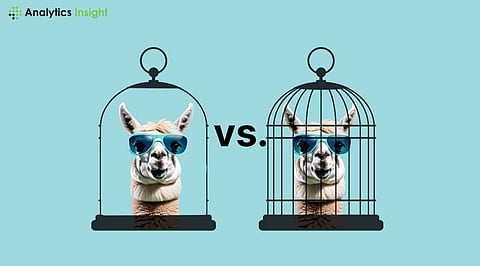

Have you ever wanted to know why there is an ongoing trend in implementing open-source AI models? When it comes to choosing open-source or closed-source models, the latter offers such solutions as Llama 3.2. However, how can they effectively compare to closed-source programs for instance? Let us discuss the benefits it gives and why Llama 3.2 can be the future of AI.
Among the key strengths of Llama 3.2, one should mention its flexibility. One of the major advantages of using open-source models is the capability of making changes in the code. However, closed source models restrict users to make only changes on set parameters. This lack of customization can become an issue when using AI for business purposes and may require a custom-built solution.
Llama 3.2 offers access to its full codebase, enabling developers to optimize and even improve the model. This kind of freedom encourages innovation. It also allows for quicker bug fixes and feature additions, driven by a global community.
Do you believe the black box model doesn’t reveal how it works? While closed-source models are powerful, they tend to be proprietary, leaving users unable to see how the AI reaches its end. Llama 3.2, being open source, provides full transparency. Developers can watch how decisions are made in the model, making it easier to understand the reasoning behind each prediction. This transparency builds trust, especially in industries such as healthcare and finance, where understanding AI behavior is critical for compliance and ethical decision-making
Most of the closed-source models incur heavy licensing costs thereby shutting out small and medium enterprises and individual developers. On the contrary, Llama 3.2 is a free model. By adopting this model you don’t have to pay license or renewal fees. As a result, the use of AI technology and applications becomes feasible for micro and small firms.
Moreover, the open-source model’s sustainability is complemented by the development of the likes of Llama 3.2. This co-management minimizes the expenses associated with both development and maintenance.
Llama 3.2 does not only compete on the basis of transparency or costs, but it has a solid performance record also. Optimal benchmarking testing indicates that Llama 3.2 competes with the majority of the closed systems. Thanks to the proprietary features of closed systems, AI models such as Llama 3.2 have enhanced resource optimization for models like “Llama-3.2-Lightweight” which is designed to perform efficiently under low computational demands.
It plays a vital role in activities where quick processing of data is required for example mobile artificial intelligence applications and edge computing. Closed systems have very expensive resource requirements, Llama 3.2 on the other hand, can expand on cheaper infrastructures.
As the saying goes, there is strength in numbers; any model that has a community will never stagnate. There are researchers, developers, and AI enthusiasts from all over the globe who help in the creation of Llama 3.2. Closed source models which are developed in a corporate environment have a small group of people who do the upgrades and improvements. Those individuals may be exceptional, but they cannot compare to people all over the world willing to work on a specific project without borders.
Community-oriented development also entails quicker fixes and more updates than the normal bracing circles. It's not just one company’s focus; it is a connecting form of innovation globally.
Are you concerned about data protection? In most closed-source models, you will have to upload critical information to third-party cloud services owned by corporate monopolies. This causes some serious privacy issues related to proprietary data and information. On the contrary, Llama 3.2 is an open-source model. It allows you to install data within your servers and thus you can retain complete control of your information. This protects your interests against such regulations as GDPR and HIPAA.
For companies that consider data security to the top, the possibility to own and control the infrastructure is the value added. With closed-sourced ones, the services offered are totally dependent on the security measures applied by the provider whether they are up to standard or not.
Llama 3.2 pushes boundaries with its multimodal models, combining text and vision capabilities, and optimized lightweight models for edge deployment. Closed-source models often focus on centralized, cloud-based solutions that limit real-time edge use.
Llama 3.2 goes one step further by integrating text and vision in its multimodal models and by preparing lightweight models for edge deployment. While the closed-sources model is based on the central cloud where the system is confined and edges can hardly be used in real-time.
Llama 3.2's edge-ready design provides a competitive advantage in sectors such as retail, medical, and transportation systems. These sectors rely on low-latency artificial intelligence systems in which users travel with the system or within physical premises. This makes it suitable for sectors that seek to install AI systems near their data sources and avoid the use of cloud computing.
Previously, closed-source models were the only way to properly achieve the performance and feature set of state-of-the-art performance models. The accessibility of high-level models in Llama 3.2 is becoming less and less of a problem. They are on the left in part because of their numerous advantages. In contrast to the models behind network limits, they offer community support, openness, and flexibility.
Due to the growing acceptance of Llama 3.2 and other open-source models as the standard, an increasing number of societal segments are looking for transparent, adaptable, and reasonably priced representations of AI.
Llama 3.2 does not in any way support the claim that open-source models are mere substitutes. They have the potential to solve AI problems. Llama 3.2 has offers that the closed source can sometimes weaken, from flexibility and price to openness and effectiveness. When you want to use AI more without spending too much or losing control, the next development is Llama 3.2.
